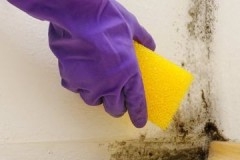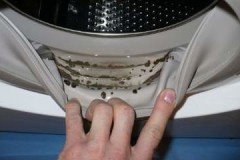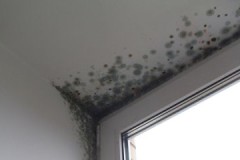How to carefully and effectively remove mold from fabric at home?
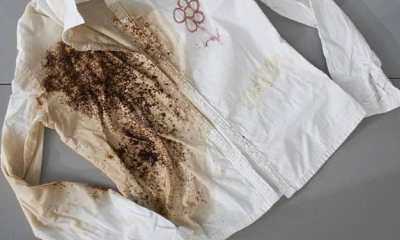 Fungal spores can only be seen under a microscope, but under favorable conditions they quickly develop and affect everything around.
Fungal spores can only be seen under a microscope, but under favorable conditions they quickly develop and affect everything around.
If things are stored in a humid and warm room without periodic ventilation, the chances of mold growing significantly increase.
Moldy things are dangerous because the fungus can quickly spread to the closet, other furniture and walls. Also, some types of mold cause an allergic reaction in humans, and it is almost impossible to get rid of it if it spreads on a large scale.
Content
How to remove fungus using traditional methods?
How to remove mold from fabric at home? The sooner you start acting, the better. It is more difficult to wash stubborn mold, especially since other things remain in the danger zone.
If you don’t have any chemicals at hand, you can start fighting the fungus with what you find in the kitchen:
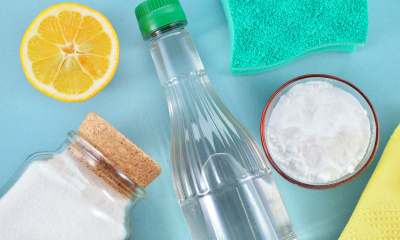 9% vinegar;
9% vinegar;- laundry soap;
- table salt and lemon juice;
- ammonia;
- chalk;
- dairy products;
- hydrogen peroxide;
- boric acid;
- turpentine;
- soda;
- onion;
- aspirin.
There are many ways to remove mildew stains from fabrics, depending on what you have in your home and the type of fabrics. If one option doesn't help, you can always try the next one.
Acetic acid
This method will not only help you wash the item, but will also eliminate the unpleasant smell of fungus.
How to use for hand washing:
- Add 20 ml of vinegar to 1 liter of water.
- Soak the item in warm water for 60 minutes.
- Wash with detergent.
Laundry soap
 The use of this product has no expiration date. Laundry soap is often used to remove difficult stains. Soap can easily deal with mold stains.
The use of this product has no expiration date. Laundry soap is often used to remove difficult stains. Soap can easily deal with mold stains.
To do this, you need to soap the fabric well, paying special attention to stains, leave for an hour and then rinse with warm water. Since laundry soap cannot cope with the smell of fungus, it is recommended to add vinegar to the water.
Kitchen salt and lemon
These two products are often used to remove dirt and bacteria. Apply lemon juice, preferably fresh, to the stains and sprinkle with salt.
It is better to dry in a well-ventilated area or outside. Then you need to wait until the juice is completely dry, and then wash it with the addition of powder. Fresh tomato juice is a good alternative to lemon juice..
Soda
Caustic soda is found in every kitchen. Since the product is included in soap, it can be used to remove various stains.
To use this substance to get rid of mold, you need to dilute it with water to a paste and rub it into the dirty areas with a brush. After 10-15 minutes, rinse with cool water.
Ammonia
 Ammonia is used for washing synthetic products. To do this, mix alcohol and water in equal proportions.
Ammonia is used for washing synthetic products. To do this, mix alcohol and water in equal proportions.
Then rub the moldy areas of the fabric with this solution and leave for 20 minutes. Then wash with detergent.
Alcohol will not eliminate the unpleasant smell of mold, so it is recommended to wash the fabric with vinegar or lemon juice.
Chalk
It is advisable to use chalk to remove mold from colored fabrics. Mode of application:
- Crush the chalk into powder.
- Apply it to the stains.
- Cover with waterproof paper.
- Iron.
- Clean the fabric from the powder.
When heated, the fungus should be absorbed into the chalk and completely come off the product.
Curdled milk or other fermented milk products
 There is no need to always rush to get rid of sour milk, because it can be useful in removing various stains.
There is no need to always rush to get rid of sour milk, because it can be useful in removing various stains.
Kefir, sour cream, and yogurt do an excellent job of removing mold.
To do this you need:
- Soak the fabric for half a day in fermented milk product.
- Wash with added detergent.
- Dry thoroughly.
Use of household chemicals
If the fungus has already eaten into the product and folk remedies do not cope, you can resort to household chemicals.
You need to choose based on your financial situation and type of fabric. For example, “Whiteness” cannot be used to remove stains on woolen products.
Domestos
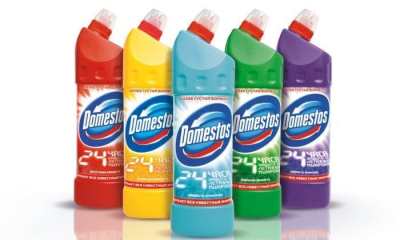 A universal product in the form of a gel has an antibacterial effect.
A universal product in the form of a gel has an antibacterial effect.
Contains chlorine and copes well with fungus, mold, greasy dirt and eliminates unpleasant odors. Cost - 70-90 rubles per liter.
To get rid of mold on fabric, you need to dilute 20 ml of liquid in a liter of water, rub the stains with the solution and wash in warm water after 15-20 minutes.
It is better to first try washing a small and inconspicuous area of the product and see if the color changes. The product has a whitening effect.
White
Chlorine bleach eliminates fungal odors and works great on mold stains on clothes. Sold in liquid form. Cost - from 40 rubles per liter.
The procedure for removing stains differs from using other products:
- Dilute 2 tablespoons of “Whiteness” in a liter of water.
- Place the mixture on the fire and bring to a boil.
- Moldy products must be completely immersed in the solution.
- Leave for 10-15 minutes.
After this time, the stains should disappear and the water should become cloudy.
Vanish
 A strong stain remover can also cope with mold on clothes. Vanish has long established itself as one of the best detergents, capable of removing even the most difficult stains.
A strong stain remover can also cope with mold on clothes. Vanish has long established itself as one of the best detergents, capable of removing even the most difficult stains.
Can be used with all types of fabrics. The product has a pleasant aroma that will completely eliminate the smell of fungus.
Manufacturers offer three ways to remove stains: soaking, machine washing or wiping.
The product comes with a special cap in the package, which is used to measure the amount of detergent. Cost – 300 rubles per liter.
How to remove from delicate materials?
Delicate fabrics usually include silk and wool. To remove mold stains from items made of delicate materials, you need to use gentle products. They will carefully clean the item from fungus.
- A solution of salt and ammonia. In a liter of water, dilute 6 tablespoons of salt and 2 teaspoons of ammonia. Put the water on the fire and wait until the mixture boils.Then you need to cool the solution, apply it to the stained areas and leave for a couple of hours. Then wash it in the usual way and add detergent. You cannot use a solution that has not cooled down, as these fabrics do not tolerate hot water well.
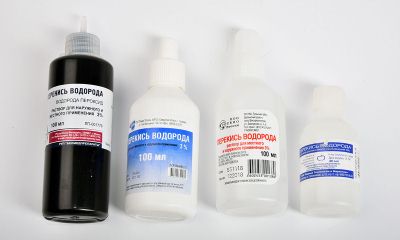 Hydrogen peroxide. The product is in every home medicine cabinet. Dilute 5-6 tablespoons of peroxide in 500 ml of water and rub the solution onto the stains. After 20 minutes, wash the items in soapy water and dry well.
Hydrogen peroxide. The product is in every home medicine cabinet. Dilute 5-6 tablespoons of peroxide in 500 ml of water and rub the solution onto the stains. After 20 minutes, wash the items in soapy water and dry well.- Turpentine. To get rid of mold with turpentine, you need to thoroughly rub the stains with it. The difficulty is that turpentine will leave greasy marks on the products. Removing greasy stains will take some time and you will need talc or baby powder. It is necessary to sprinkle the marks with powder and leave for several hours. Then wash the product as usual.
From white
Removing mold from white products is a difficult and complex process. It may require the use of not one, but several products that will gently clean the item from stains and leave no traces.
How to do it:
- It is necessary to pour hot water into a basin and add 1-2 tablespoons of washing powder.
- Rub mildewed areas with laundry soap.
- Immerse the products in a bowl of water for half an hour.
- After the specified time, you need to wash the item in a machine with the addition of a hydrogen peroxide solution. Add half a liter of water and a tablespoon of peroxide to the soap container.
From synthetic
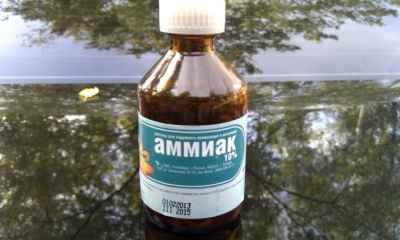 To remove fungus from synthetic items, ammonia is used:
To remove fungus from synthetic items, ammonia is used:
- Add a few drops of ammonia to 100 ml of water.
- Rub the resulting mixture onto the moldy areas, rub them and wait twenty minutes.
- Machine wash with detergent at high temperature.
- Dry the product well.
Prevention
Like many problems, mold can be prevented. Following a few simple rules will help you avoid the hassle of mold stains on fabrics.
To do this you need:
- Regularly ventilate the room and cabinets. Fresh air will not only help prevent mold, but also have a positive effect on your health.
- Do not put dirty and clean clothes together. It is advisable to immediately send dirty items to the wash. The risk of mold growing on unwashed items is higher.
- Do not place cabinets and chests of drawers close to the walls. This is especially true for corner rooms.
- Do not rush to put clothes in the closet after ironing. Condensation generated during ironing also represents moisture. It is advisable to wait another 15-20 minutes until the item dries.
- Use moisture-absorbing products. Special bags that absorb moisture will never be superfluous and do not take up much space in cabinets.
Useful video
This video will show you how to get rid of mold on fabric:
Conclusion
If you try hard, then remove mold from clothes it will work out. If the problem is noticed and eliminated in time, it will not create dire consequences, but it is advisable to follow the rules of hygiene and prevent fungus from appearing in the house.
